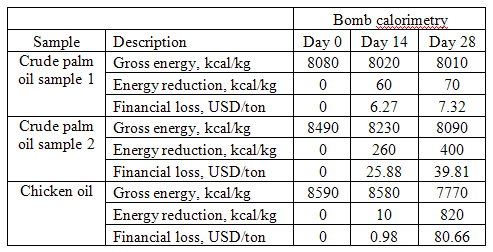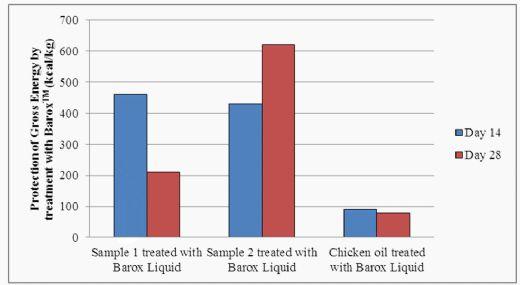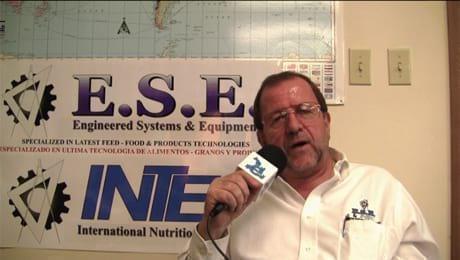Antioxidants, Gross Energy and Cost Savings
Published: October 20, 2010
By: Ms. Lin Huixin (Kemin AgriFoods Asia), Dr. Ng Sek-Yeo
Oils and fats are used in feed formulations and are susceptible to oxidative spoilage. In foods and feeds, oxidation is an automatic and irreversible process by which molecular oxygen combines with nutrients in food and feed to decrease the quality of the food and feed creating rancidity. The main problems that are associated with the autoxidation of feeds are
- (a) destruction of fat soluble vitamins and xanthophylls,
- (b) decrease in feed palatability,
- (c) creation of toxic metabolites,
- (d) decrease in productivity,
- (e) decrease in reproductivity,
- (f) negative influences on animal health and performance.
The price of crude oil has been increasing steadily over the past months. This increasing trend of oil prices coupled with the fact that a lower amount of metabolizable energy will be available to the animals as oils and fats oxidize makes it crucial to secure the energy value of the fats and oils in the feeds to optimize animal growth and performance. In addition, by preventing the feeds from undergoing oxidative spoilage and maintaining the gross energy level also imply higher financial gains for the farmers.
The gross energy of feeds and feed ingredients can be measured using a bomb calorimeter. Oils and fats are feed ingredients that are commonly used in the Asia Pacific region and are usually stabilized with antioxidant. Table 1 displays the reduction in the crude palm oil energy and the estimated financial losses. Using the estimated price of crude palm oil at USD0.845/kg, every 1 kcal/kg reduction in gross energy equates to the financial loss of USD0.10. This article records the calorimetric determination of two crude palm oil samples obtained from different sources and one chicken oil sample. The aspect of BaroxTM application and maintaining the overall gross energy of oils thereby leading to cost savings are also discussed.
Table 1.Reduction in crude palm oil energy and financial losses


*Note: The estimated price of crude palm oil of USD0.845/kg was used for this calculation.
Table 1.Reduction in crude palm oil energy and financial losses


*Note: The estimated price of crude palm oil of USD0.845/kg was used for this calculation.
Bomb calorimetry. The gross energy value of feed or feed ingredient can be measured using a bomb calorimeter. The two crude palm oil samples and the chicken oil sample were kept at room conditions and their gross energies were determined on day 0, 14 and 28. The results obtained from bomb calorimetry are displayed in Table 2.
Table 2. Effect of oxidative stress on gross energy levels and financial impact.

*Note: The estimated price of crude palm oil of USD0.845/kg was used for this calculation.

*Note: The estimated price of crude palm oil of USD0.845/kg was used for this calculation.
All the results show there was a reduction in the gross energy of the oil samples from day 0 to day 28 indicating the three samples have undergone oxidative spoilage. The three oil samples had original gross energies of 8080, 8490 and 8590 kcal/kg. Sample 1 lost 60 and 70 kcal/kg after 14 and 28 days of storage respectively indicating there was oxidation and degradation of the samples. These amounts of energy losses translate to a financial loss of USD6.27 and USD7.32 per ton respectively. Sample 2 and chicken oil exhibited higher amounts of energy reduction and thus leading to higher financial losses.
One portion of the oils was treated with BaroxTM Liquid. The samples were placed in room temperature and the oils were analyzed after 14 and 28 days of storage. The results obtained are displayed in Table 3 and Figure 1.
Table 3. Effect of oxidation and antioxidant treatment on gross energy level of oil samples at different stages of oxidation.

Table 3. Effect of oxidation and antioxidant treatment on gross energy level of oil samples at different stages of oxidation.

Figure 1. Effect of oxidation and antioxidant treatment on gross energy level of oil samples at different stages of oxidation.

The gross energies for the crude palm oil samples that were treated with BaroxTM Liquid were significantly higher than that of the initial untreated oil samples at day 0. However, the gross energy measured at day 14 for the chicken oil sample was higher than of the initial while the gross energy at day 28 was lower than the initial amount of 8590 kcal/kg. Furthermore, the gross energies for all the oil samples that were treated with BaroxTM Liquid were higher than that of the untreated oil samples at the same day of testing. The smallest difference was found to be 80 kcal/kg for the chicken oil treated and not treated with BaroxTM Liquid at day 28. Using the same calculation with the estimated price of chicken oil at USD0.845/kg, the reduction of 80 kcal/kg translates to the financial loss of USD8. The results clearly indicate that the antioxidant offers protection on the oil as oils treated with the antioxidant exhibited lower energy losses, translating to cost savings and better animal performance.
CONCLUSION
All the results confirm that lipid oxidation has a negative effect on the gross energy levels for oils. Upon oxidative spoilage, the oils will lose energy value and the energy reduction of 400 kcal/kg translates to a financial loss of USD39.81/ton of oil. Stabilization of oils with BaroxTM Liquid is very effective in maintaining the gross energy levels and nutritional values of the feeds, and also the overall well-being of the animals. BaroxTM Liquid is a powerful liquid antioxidant to stabilize fats, oils and protein meals which are highly susceptible to autoxidation and rancidity. Thus, feedmills can save money by securing the stability of oils and fats with BaroxTM Liquid.
Related topics:
Authors:
Kemin Industries, Inc
Recommend
Comment
Share
Recommend
Reply
21 de octubre de 2010
Dear Ms Lin,
The case study is a self explainatory that use of Antioxidants in Fat/Oil directly or in finished feed will save the energy losses in storage.
But i have some below querries on the subject matter:...
1) Why you have selected the Crude palm oil as study material as oxidative changes
are more related with unsaturates so we expect you will work on the Soya crude
oil in the same way.
2) The Oil sample collected & mentioned Zero day is immediate after oil production
i.e. before staring the auto-oxidation reactions?
3) If samples collected at Zero days have not started any Oxidation reactions then
after adding the antioxidant by which phenomenon energy will increase during the
storage. eg.Sample II treated with Barox : Gross energy value at 0 day is 8490
Kcal/Kg, at 14 day 8660 kcal/kg & at 28 day 8710 Kcal/kg.
4) By which phenomenon after adding the antioxidants in Oil increases the gross
energy in storage too. Please elaborate the same to upgrade our knowledge.
Thanks & regards,
Dr Jaydip
Recommend
Reply
21 de octubre de 2010
Author Ms. Lin did an excellent work to establish financial impact of oxidation of oils. Antioxidants play very important role not only to preserve stability of oils but also other products by preventing the products from the process of oxidation. I must request author to extend her study to calculate the financial impact of oxidation on grains or any other product used in feed formulation.
Especially in Pakistan, where commercial feed producers are manufacturing low density and low energy diets virtually without the addition of any oil or fat and still they are economically viable and profitable.
I wish, if Ms. Lin could put some light on the use of antioxidants on grains and other materials too with the financial impact.
Recommend
Reply
Kemin Industries, Inc
20 de octubre de 2010
Good article.. The calculation of financial losses due oil spoilage is very interesting. Apart from gross energy losses due to rancidity, there will be reduction in the vitamins and other additives level in the final feed,when we use damaged oil in poultry feed.
Recommend
Reply

Would you like to discuss another topic? Create a new post to engage with experts in the community.











